NB: This post is pure gardening geekery with a little humor here and there. If that’s not your gig, you can safely skip this one.
I did a Garden 2024 June edition last season, and I thought I would follow up to compare and contrast the current season.
Some quick background for those not from southeast PA… We had a severe drought last season from mid summer through October. Moisture returned in November, but we recovered from the dry conditions only very recently, with a very wet period from early May through mid June. It was a cool and very wet spring — not cold, but too cool for warm weather plants (like tomatoes) to thrive.
With an unusually early frost-free date likely, and no way to anticipate how persistent the dreary conditions would be well into June, many gardeners transplanted warm weather plants a few weeks early (late April into early May). Predictably, tomatoes, peppers, eggplant, cucumbers, etc. mostly just survived and whined. Frequent overnight temperatures in the mid to upper 40’s, and excess moisture for six weeks, were not enough to kill most plants. But they created very unpleasant conditions for plants that prefer to put on a pair of shorts and a tank top and work on their tans. On the other hand, it was a fantastic spring for lettuce and greens, which love the moisture and cool weather, and prefer sitting in bars to basking in hot, direct sun. So it was a good spring to be lettuce. Tomatoes? Not so much.
Much has changed in the past week or two, with a rapid shift toward summer weather and the first serious heat wave on tap for next week. And many gardeners in the area are seeing their warm weather plants respond accordingly. So let’s take a look at my back yard…
Let’s start with the reliable staple of my gardening life: lettuce. This is the time of year when the first planting of lettuce begins to wane, and a second planting takes center stage. The remarkable / scary thing is how similar the situation this year is to last year at the same time. Here are a couple shots of the first and second planting this year, as of today:

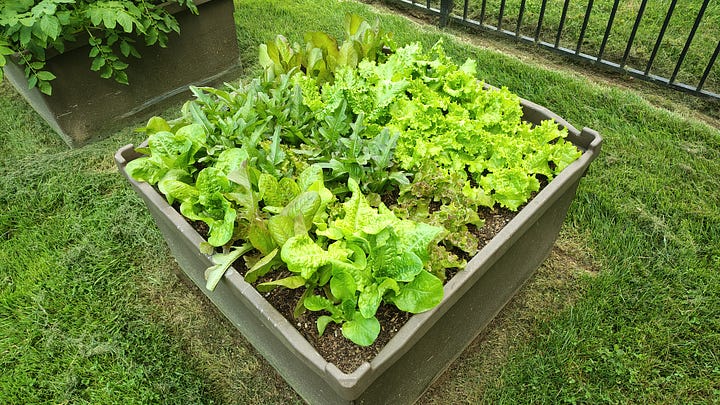
And here’s where things stood last year at the same time:
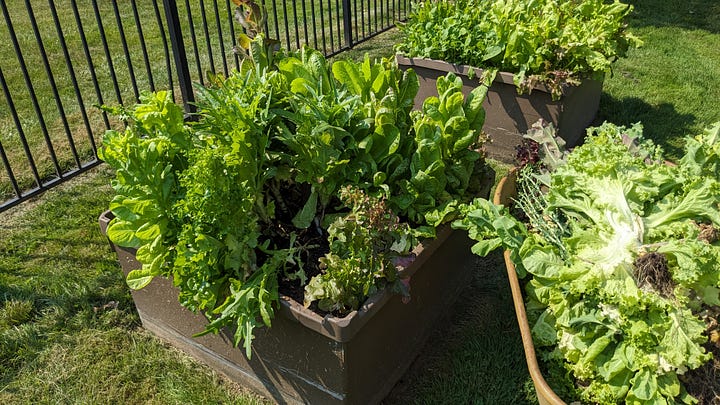

Oh sure, Round 2 might be ever so slightly behind this year. But what this mostly shows, beyond any doubt, is that I need a life. So there’s Lesson Learned #1.
Moving on…
I conducted a few experiments this season for the fun of it, and because, well, that’s what I do (see: “Tom needs a life”, above).
Experiment #1: Short day vs. long day onions.
Some background: As a young lad, the party line in all the garden catalogues was that you should grow onions from “sets” or “starts” rather than from seeds. “Sets” are just small onions that you put in the ground. “Starts” are small onion plants that someone else grew from a seed. Both struck me as (a) cheating, and (b) too expensive for a kid whose entire annual budget consisted of birthday money. It all looked like a grand conspiracy of Big Gardening — my instinct to bristle at such corporate manipulation formed young. So I swore off growing onions at a young age. My first protest! Aww, kinda makes you teary, doesn’t it?
Fast forward forty years — maybe thirty, I forget — and the newfangled interweb machine revealed the deep and dirty secret that Big Gardening didn’t want to reveal to my kid self. You can buy onion seeds. And so I started buying onion seeds. There are a few lessons here that I don’t have time to share, but I’ll just say that it wasn’t quite the grand conspiracy that my already cynical nine year-old mind wanted to conjure. It turns out that onion seeds can be temperamental. A discussion for another time.
But onions can be finicky in general. Which brings me to my grand experiment. You see, onions care about latitude. In case you’ve never really thought about it, a mid-summer day in, say, Jacksonville, Fl, is about an hour shorter than the same day in, say Philadelphia, PA. And the length of day in Jacksonville doesn’t change much between March and June, whereas it changes a lot in that time in Philly (the March day is much shorter in Philly). Weirdly, this all matters a lot to onions. Or so they say — my conspiracy sniffer wanted to know if I’m being sold a bill of goods by Big Vidalia.
Experts advise gardeners to buy onion varieties that comport with your latitude. I always wonder who these “experts” are, and what qualifies them as such — vs., say, “slightly less clueless than most”. But I won’t quibble here. So, for example, at 40° north, Walla Walla is a favored substitute for Vidalia, which prefers shorter days (or so they say…). Well, I accidentally asked for an 8-variety pack of onion seeds for Christmas. And, strangely, this pack included half short day onions and half long day onions. If you think about it (but not too hard), this would make sense only if you owned a house in New York and a house in Georgia, and split your summers between them. So the whole product was suspect as far as I was concerned. But whatever.
OR… maybe this was telling me something about Big Onion’s grand conspiracy — inquiring minds want to know. So I grew seedlings for all the varieties in the “box set” (except for the scallions, which didn’t germinate), and decided to plant them together as a cohort, in the same spot in the garden. The short day onions would be on the left side of the container, with the the long day onions to the right. See below.
For a couple months, both sides looked strikingly similar. “Aha!” I thought. “This whole thing is a scam!” I didn’t bother to consider how anyone might profit from such a scam, but don’t bog me down with all that logic stuff. I’m just a caveman — your mysterious obsession with facts confuses me.
So here’s the situation today:
The onions on the right side are now accelerating into a phase of rapid expansion of the base/bulb parts of the plants. Those will turn into large onions over the next month or so. The ones on the left side? They’ve pretty much stopped growing. And if you read the fine print on the short day packets, it says that growing them in northern latitudes will produce small but perfectly usable onions. And ya know what? That’s exactly what happened. Big Vidalia wasn’t kidding.
My conspiratorial mind isn’t doing so well. Let’s move on to Experiment #2.
Experiment #2: Growing seeds saved from hybrid tomatoes.
As my gardening friends know, my go-to fave varieties of larger tomatoes are Burpee Supersteak (large beefsteak) and Burpee Sandwich Slicer (mid-size slicing). I grow them because both are excellent compromises between flavor, disease resistance, general vigor and shelf stability. But both are hybrids, which means that, in theory, you can’t save seeds. Last year I grew a third, newer variety of cherry tomato — Burpee Two Tasty Hybrid. Unlike the other two, the seeds were laughably expensive (something like $9 for a dozen seeds? — fortunately, a friend ordered them for me and I saved the equally ridiculous shipping charges …and, come to think of it, I think she paid for them… Note to Self: Find more friends like that). But the plants and tomatoes were wonderful. So it got me to wonderin’. Two Tasty is expensive in part because it is a new variety. It takes time to develop such things, and the company is likely just doing what all tech companies do — i.e., asking early adopters to pay for their R&D. Supersteak and Sandwich Slicer have been around for a long time, and you can find those seeds for well under $3 per packet, which is on the low end for name-brand seeds in general these days, let alone for quality tomatoes.
There are different types of hybrids. I won’t get into that here. But even my conspiratorial mind accepts that true “F1” hybrids (so-called by horticultural nerds) will generally not reproduce true to type. Two Tasty is almost certainly F1. But the other two? Why would they be selling real hybrids at a serious discount, particularly good ones? (A: Because gardeners get bored like everyone else — but let’s not bring reality into this. And also because I have no idea how seed markets work, but, again…).
So I decided to save and grow some hybrid seeds. Just to clarify, doing this with Two Tasty is probably illegal, as they probably still have some sort of intellectual property claim on those, but who knows. I wasn’t planning on doing anything with them — this was all in the name of fake science. But I was genuinely curious about the other two varieties, as I suspected that they might be stable, “open-pollinated” varieties by now, which are much less expensive to grow, and very well might reproduce true to type with saved seed.
Let’s get the easy stuff out of the way — the Two Tasty saved seeds were a complete, utter, epic fail. I wish I had a photo, but it’s probably best that I don’t. If you’ve ever seen Eraserhead (DON’T!!!), that’s kind of what these plants evoked. They germinated, looked like a weird alien life form, tried to develop a couple meek pairs of leaves, then stopped growing and quickly expired. The genetics were clearly awry in these second generation seeds. Not unexpected. End of Experiment 2a.
The jury is out on Supersteak and Sandwich Slicer, but, as we will see, I think I have the classic case of an experiment with too many variables. They started promisingly enough. Here they are entering a growth phase and hardening off period, looking stunning and full of promise in mid April:
I was hopeful. Just instinctively, I strongly suspect that the plants answered my basic question by getting to this stage so effortlessly. Unfortunately, the rest of the experiment has been a comedy of bad luck and poor judgment. Here are the same plants now:
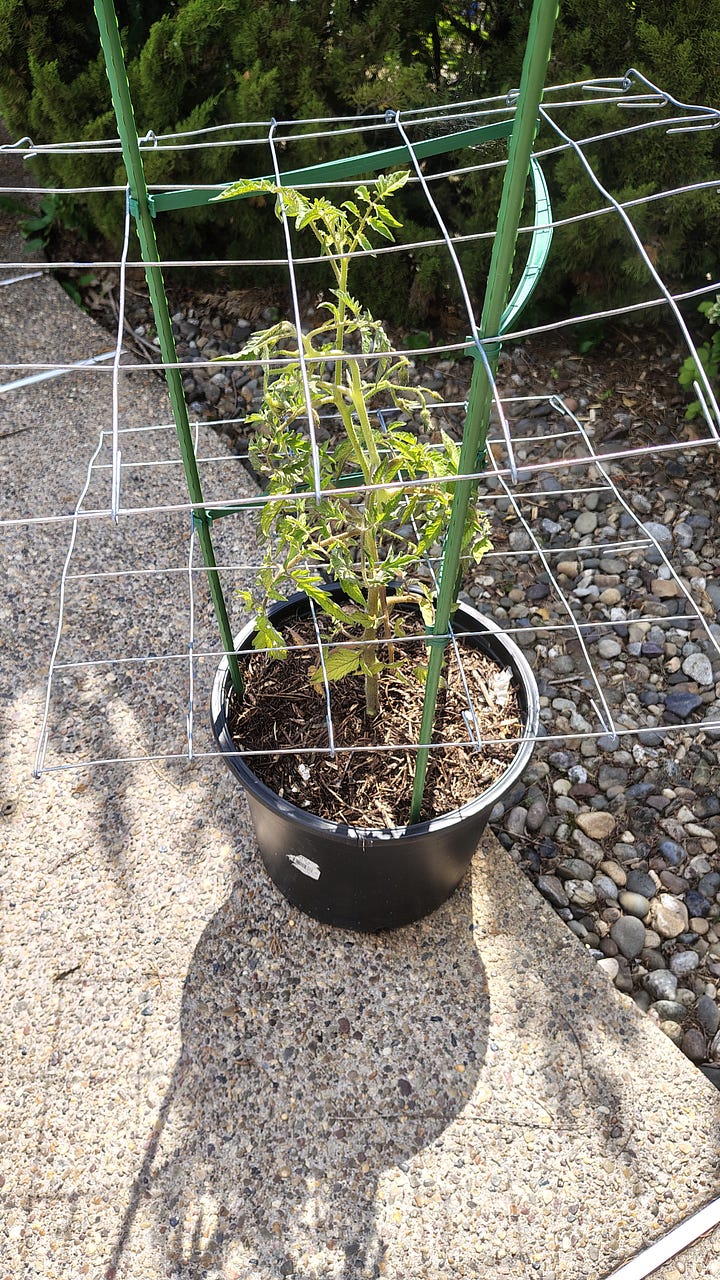
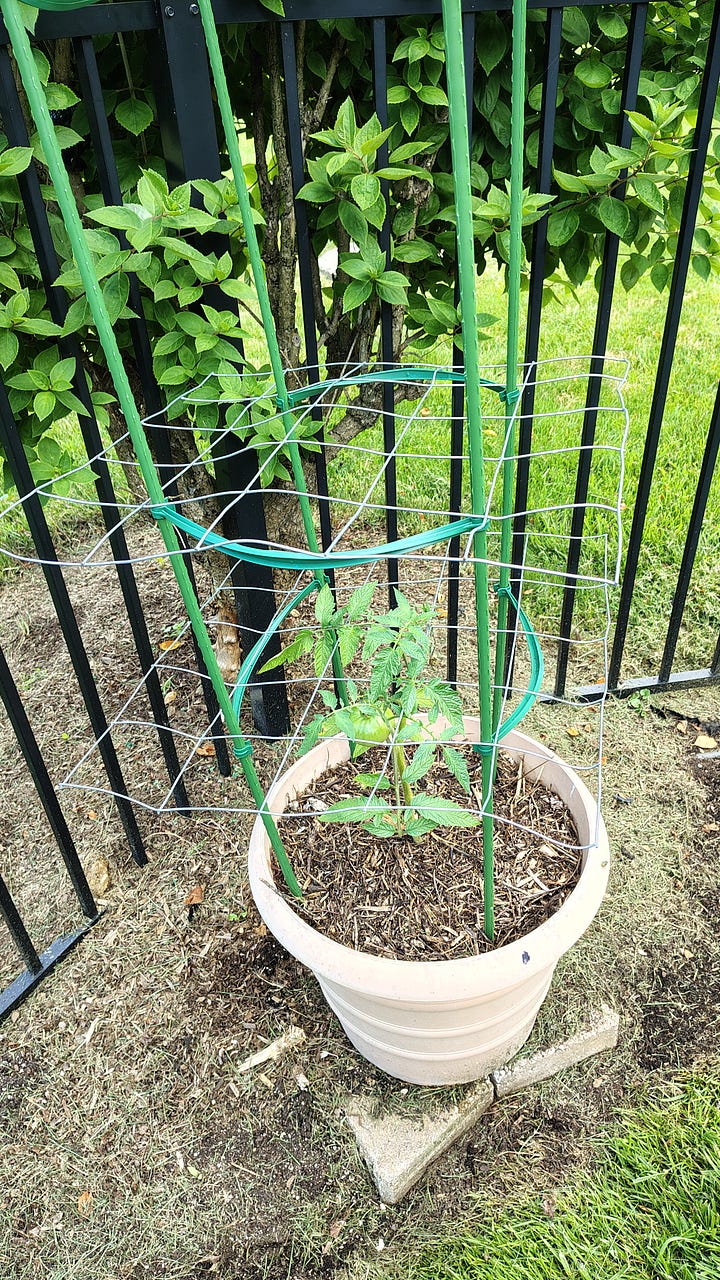
The first one is a lost cause. The second shows some small signs of hope. Let’s contrast these with two plants from official packet seeds:
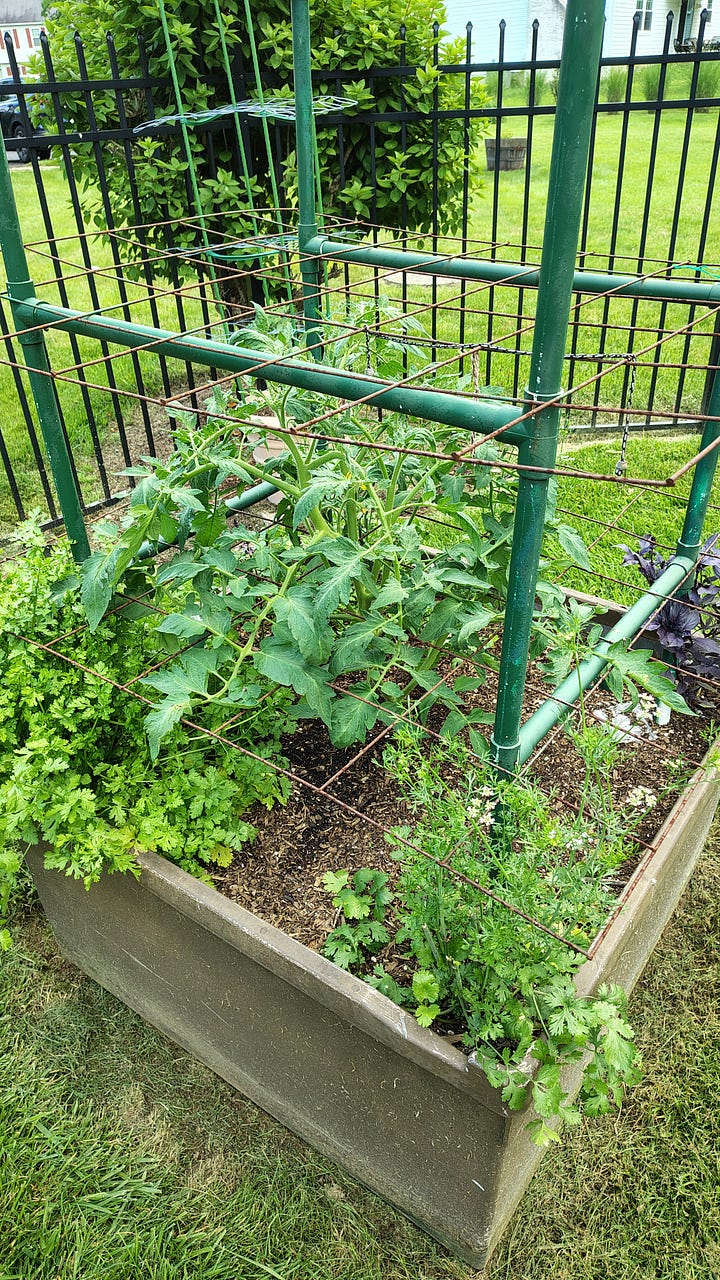
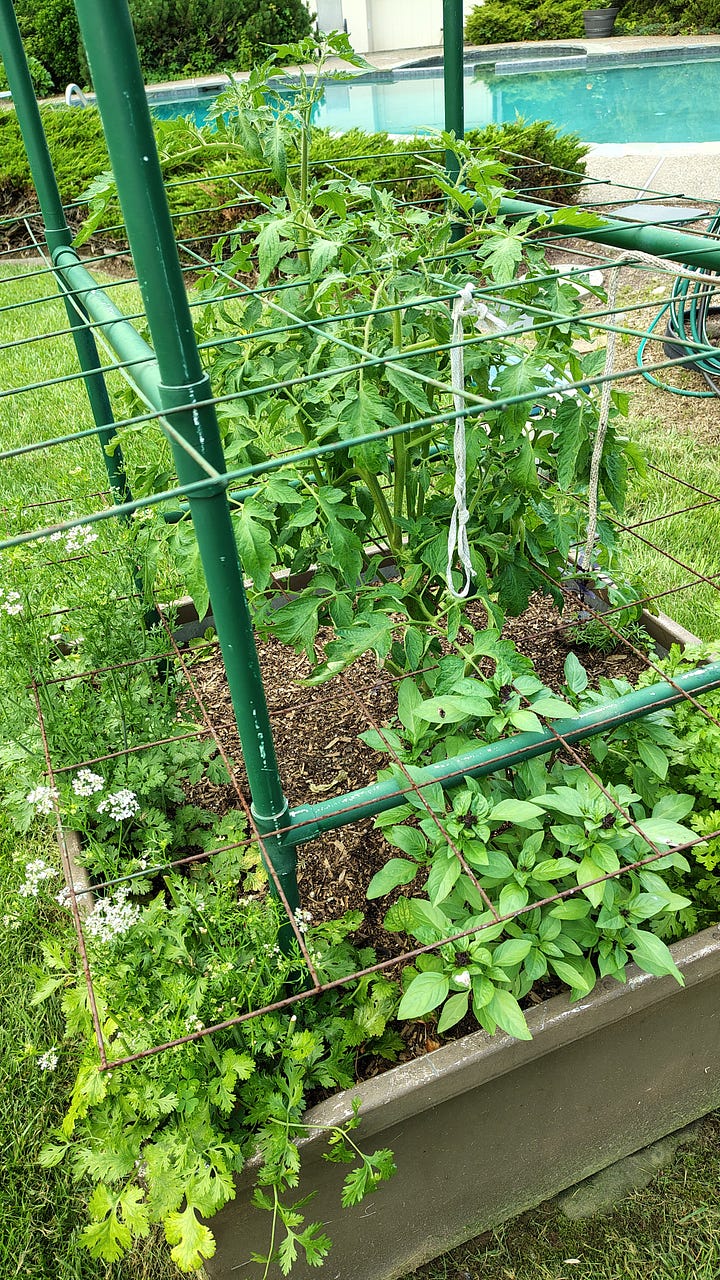
These are entering their explosive growth cycle, right on schedule. I should also mention that these were a month behind the experiment plants — they were barely germinating when the experiments had reached their glory days in the photos above. And yet, here they are, quadruple the size with a bright future.
So what happened? I’m not sure, but it is almost certainly one or a combination of a few factors:
Bad weather fortune. See discussion at the beginning of this post. Because I started the experiments so early (in February), I was forced to take a chance and plant them outdoors early. And I suspect they were damaged.
Soil issues. I bought some commercial “compost” this spring. It is a higher percentage of the soil in the pots hosting the experiments. See later discussion.
New support system is toxic? Longshot, but it’s a variable so I will mention it. This season I played with a less expensive approach to building my otherwise successful support system. It uses different materials that I have never tested. Could it be an issue? Sure. Is it likely to have done this? No.
Failed experiment. By this I mean, maybe the “saved seed from hybrid” factor finally kicked in. But, again, I suspect this is the least likely possibility, given how well the plants were doing for two months prior to transplanting.
It’s an experiment worth repeating next season. My gut says that these varieties are not F1 hybrids at this stage in their history, and I can likely begin to save seeds, in case the varieties are discontinued by Burpee. But, to reiterate, the Two Tasty cherry tomatoes are an unequivocal example of why saving seed from a true F1 hybrid is a bad idea …even if it happens to be legal ;-) There were no additional variables to blame.
Experiment #3: Pawpaw Trees!
“Whatwhat tree?”, you ask. Don’t worry, most would ask the same question. A pawpaw is a sparsely-known fruiting tree that is native to the eastern United States. It grows large fruits that invoke a banana-mango vibe. A gardening friend who loves them spotted me some seeds last year. So I did the cold stratification thing in the freezer and tried to germinate some over the winter. Somewhat surprisingly, four sprouted. And here they are:
I made a grievous mistake earlier this spring by inadvertently leaving them in full sun before they were ready. Which toasted most of the leaves. But they forgave me, apparently, and all have now sprouted replacement leaves. I will let them develop this summer in partial shade, and then probably bury the pots in the ground this winter, with some protection. So the longer term jury is still out on this experiment, but I am optimistic.
This post is running long, so I’ll skip the comprehensive garden tour for now and just highlight a few items of interest — one success, two peeves. Let’s start with the peeves.
Peeve #1: Falsely advertised seeds.
I took a chance with some online, off-brand zinnia seeds this season. I’ve been growing beautiful zinnias for six years using saved seed, which are beginning to succumb to age. So I thought I would buy some new seeds that seemed similar. Bad move. Here’s a view of last season vs. this season:
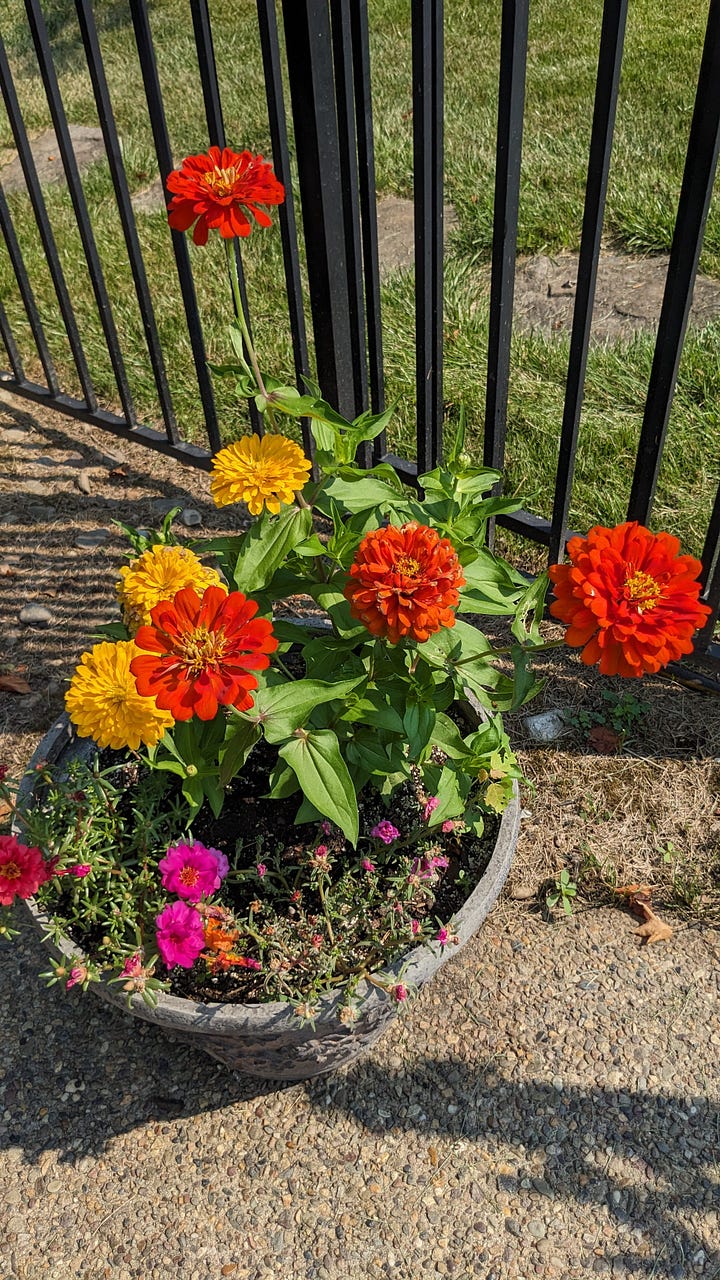
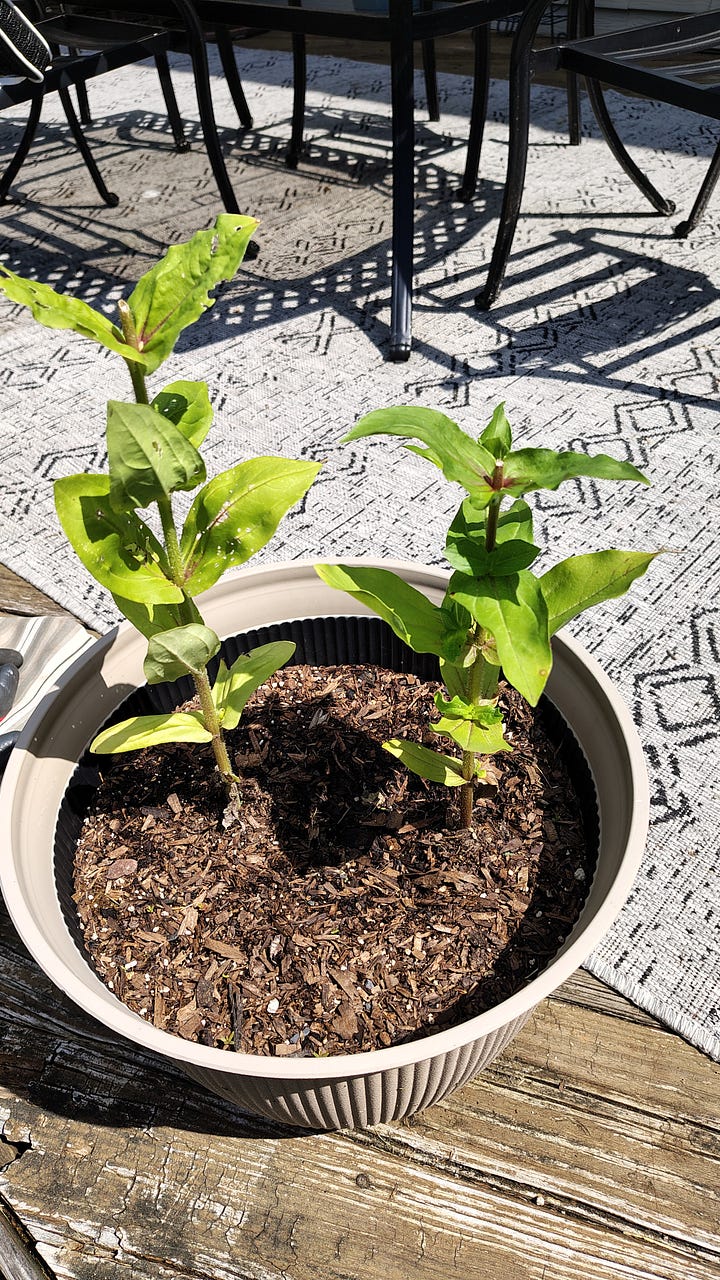
Now, to be fair, not all of them look this pathetic. But all are tall, poorly-branching varieties that are the antithesis of the online description. Caveat emptor.
Peeve #2: Falsely advertised “compost”.
So let’s start with the tell-tale evidence:
Yes, that’s a mushroom. No, I’m not growing mushrooms. My garden boxes are sprouting them because the “compost” that I bought this spring has too much wood content. When the stuff arrived, I convinced myself that it was okay, even though it was brown rather than black. And now it’s all very clear — the mushrooms don’t lie. Longer term, everything will be fine. But this isn’t acceptable. As gardeners, we need to demand some standards and quality control around what soil vendors can label various products. This stuff wasn’t compost. Or at the very least we need product grades that indicate wood content.
As an aside, this is what I was referring to relative to my tomato experiment. The two anemic plants are in pots where I mixed a fair amount of this “compost” into the soil. I suspect this isn’t the primary problem, but I am equally confident that it ain’t helping.
And, finally… Nuclear Peas!
I usually do a run of snap peas in the spring. I’ve never seen anything quite like this year. The photo doesn’t do it justice. The plants are 9-10 feet tall. They are from saved seed, a mixture of a standard green podded peas and Sugar Magnolia purple peas. It’s nuts. I guess they liked the cool, wet spring.
This is enough for one post. I don’t have time to edit this one, so please forgive any typos, unreadable prose, or general cheesiness.
Thanks for reading.







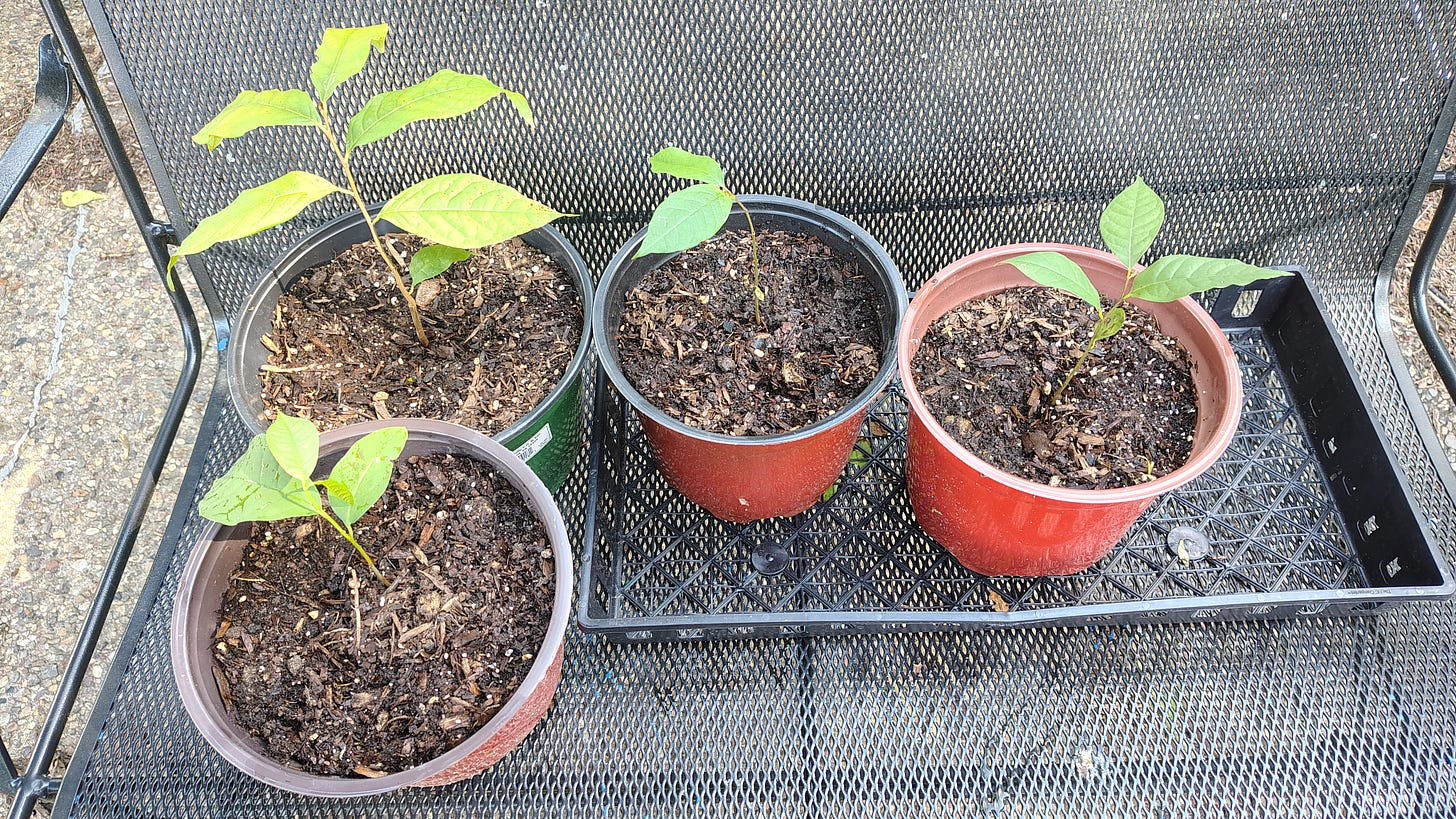
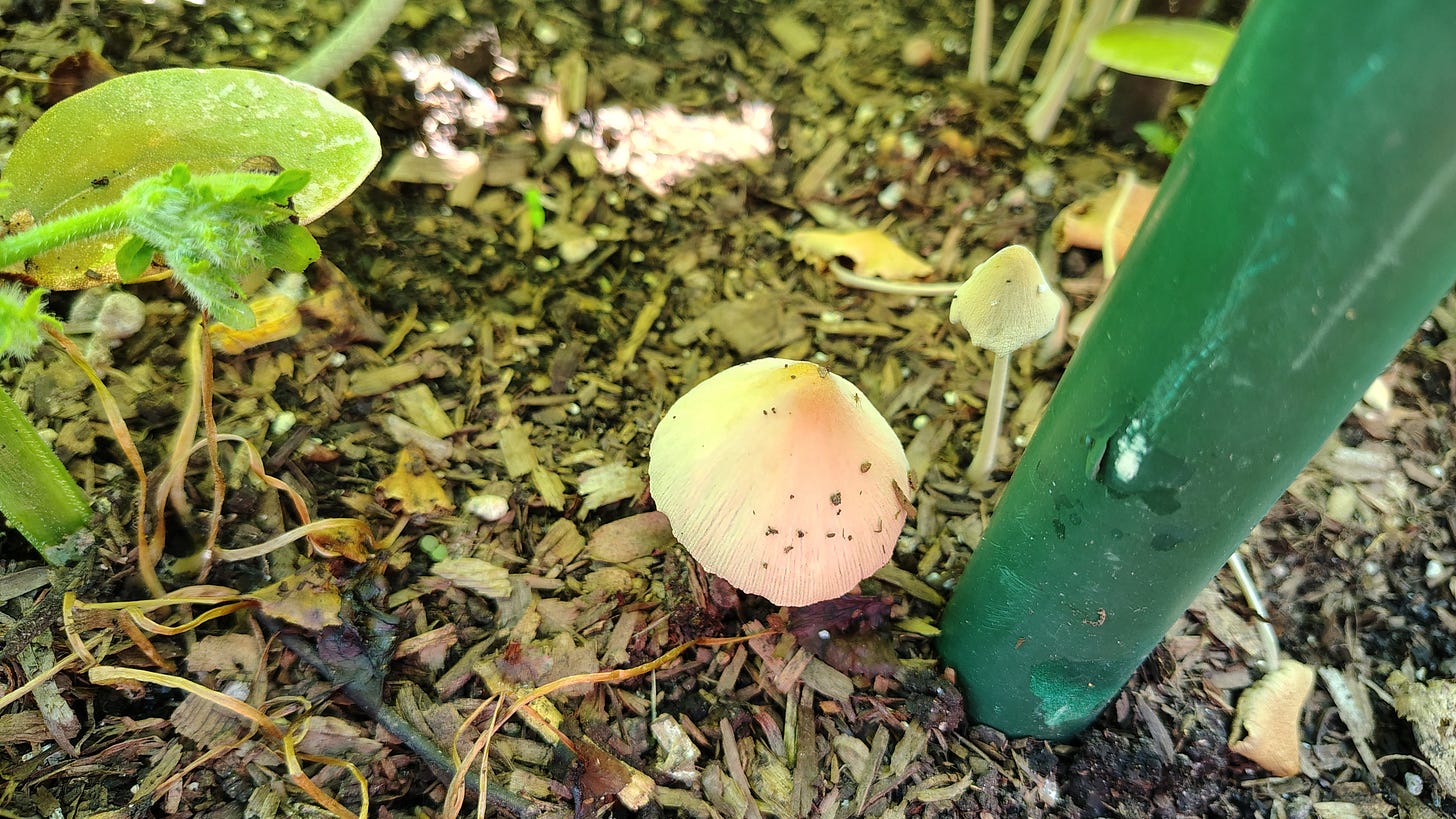
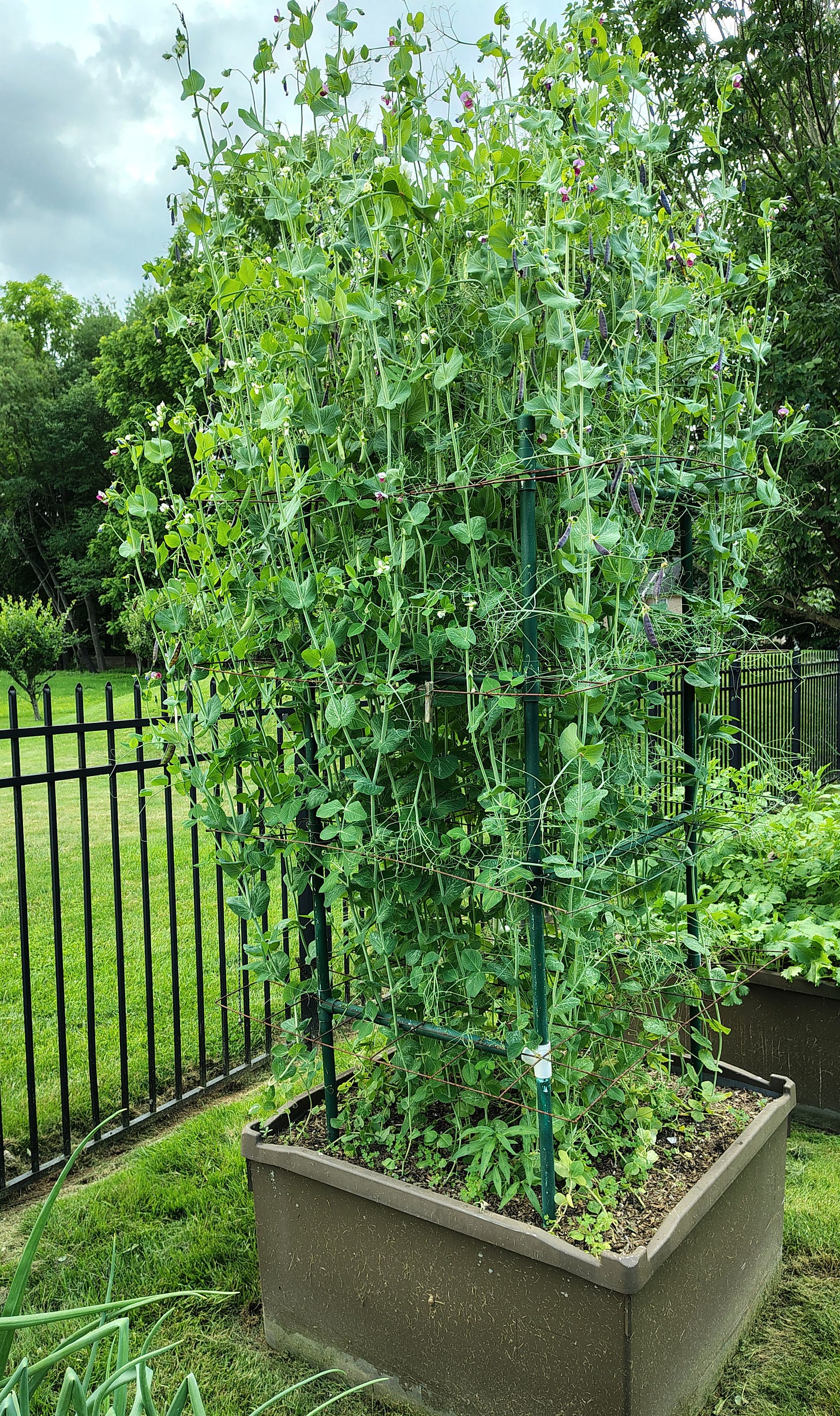
Wow! those peas are nuclear! I hope to have a bounty like yours someday! Best wishes!